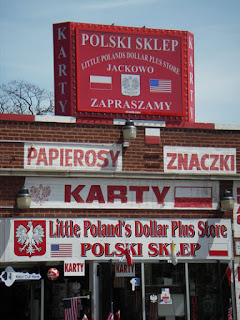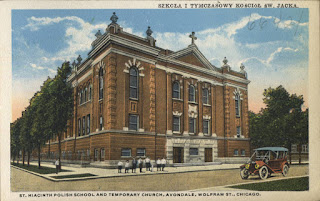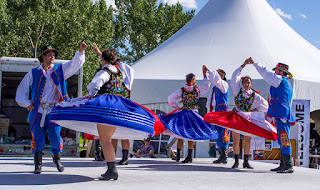Weronica Dabros was a senior majoring in Integrative Biology and minoring in Polish when she wrote this blog post in 418 ‘Language and Minorities in Europe’ in spring 2019. She was planning on applying to dental schools to continue her career in health.
They have been named the za chlebem (“For Bread”) migrants from a damaged country. They are the land hungry immigrants; the peasants, the censored, the opportunists. They are the low-skilled wage laborers. They are, as far as their origins in this country are concerned, the Polish of Chicago.
 |
| Chicago 1950 (Source: wikimedia commons) |
So, what was the cause of this immense wave of Polish immigrants into the land of economic opportunities - the land of industrial Chicago? There was a period of time where Poland was removed from the European map and was not considered a distinct political entity. The Polish were deprived of their country, language and cultural expression. The Republic of Poland has endured a very complex and rich history that in some cases required the Poles to emigrate out of their home country to search for better opportunities for freedom, land ownership, status, education and lifestyle. The initial place of landing for the Poles was the south side of Chicago in the Back of the Yards neighborhood. Over time, the Polish neighborhoods shifted from the Back of the Yards to Humboldt Park/Logan Square and eventually up to the Belmont Cragin/Portage Park area where the majority of Polish people live today.
 |
| Polish Village (source: wikimedia commons) |
One of the most popular Polish neighborhoods was located in Avondale and was named Jackowo, best known as “Little Poland”. This area was a hotspot for the Polish community in the late 1900’s, so much so, that if you were a passenger on the CTA (Chicago Transit Authority) taking the Milwaukee bus up North, the bus driver would regularly announce "YATS-KO-VO" over the loudspeaker as the next destination (LaTrace, 2016). There was a strip of Polish businesses such as bakeries, restaurants, churches, and pharmacies where Polish presence was unmistakable. The Poles came to Chicago with nothing but a suitcase and their hopes for opportunity and turned bitter lemons into sweet “cytrynówka”, a Polish lemon liqueur.
As the Polish community grew like red poppies (Poland’s national flower) in the garden that was Chicago, they established various institutions that are still used to this day. One of the many institutions is the Polish Museum of America, established in 1935 and located in Chicago’s West Town area. It holds a compilation of Polish artifacts such as art, embroidery, and folk costumes. The museum organizes frequent exhibitions to maintain remembrance of Polish origins and educate the public on Polish history and culture.
 | ||
| St. Hyacinth Polish School and Temporary Church, Avondale, Wolfram St., Chicago (Source: Wikimedia Commons) |
 |
| Wigilia (source: Wikimedia Commons) |
Modern Chicago has significantly changed since the industrial era and the Polish community has evolved along with it. Various cultural events and traditions are held in dedication to Polish immigrants who continue to create a life for themselves in the growing city.
 |
| Polish Day Parade (source: Wikimedia Commons) |
 |
| Polish dancing (source: Flickr) |
Just last year in May, the president of the Republic of Poland, Andrzej Duda traveled to Chicago to announce Polish Heritage Day (May 19th) in Millenium Park. The park was filled with the Polish community and even attracted some Poles living in areas outside of Chicago. It is clear that even in Poland and cities outside of Chicago, the city of Chicago is recognized as one of the greatest epicenters of Polish culture and history.
Being Polish in Chicago has created a foundation for Polish Americans to maintain their Polish roots and nurture their language by creating a community. This community provided Polish immigrants that were forced to leave their motherland for a chance at a better life with a second home and more opportunities for the future generations of Polish immigrants.
Citations:
Latrace, AJ. 2016. The People's Guide to Avondale, Chicago's Polish Village. Curbed Chicago. https://chicago.curbed.com/2016/4/12/11414228/chicago-avondale-neighborhood-guide-polish-village
Radzialowski, T. 1976. The Competition for Jobs and Racial Stereotypes: Poles and Blacks in Chicago. Polish American Studies 33(2): 5-18.








